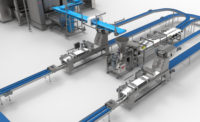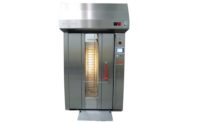The right oven is the heart of any baked snack or bakery facility—and suppliers continue to make improvements to their equipment. Aspects like smaller footprints, lower costs, more hygienic design, greater energy efficiency, better control, remote monitoring and an ability to handle a wider range of ingredients are all facing scrutiny.
A desire for better control of temperature and humidity at a lower price is the customer feedback most frequently heard by Stephen Bloom, vice president of Allied Bakery Equipment, Santa Fe Springs, CA. “The electronic interface is also a big thing these days. Everybody wants to do everything with their iPhone.
Peter De Naeghel, export manager/area manager, Heuft, Bell, Germany, hears most often from customers who want “an oven that can bake with a steady temperature, no ups and downs, so that the moisture stays in the product. Lower temperatures but longer proofing times—for that, perfect control of the humidity in the proofer is very important.”
Temperature and humidity control also comes up routinely in conversations that Luc Imberechts, owner/president, Bakon USA, Torrance, CA, has with his customers. “We seem to see a lot of people who have issues with their proofers—a lot of steam, or no steam at all, or too much water running out of the retarder/proofer. People put the dough in, it’s full-temperature on the hot side, or full-humidity, and the product comes out soaked.”
Lisa Mitchell, marketing manager, Radio Frequency Co., Millis, MA, hears a lot about how the integration of more healthful options like ancient grains and seeds can lead to chips or crackers breaking apart as the product starts to cool. “The bits and crumbs when you open the package have nothing to do with shipping and handling.”
Koenig Bakery Systems, Ashland, VA, has seen a greater interest in machines with a small footprint, necessitating custom-built machines based on space requirements, says Rich Breeswine, president and CEO. “There is also a possibility of not proofing and transporting the products with direct transfer,” he says. “Koenig has perceived a demand for products which are not proofed and will bypass the proofer.”
Buhler Aeroglide, Cary, NC, hears most frequently about food safety and hygienic design, as well as energy efficiency, says Steve Blackowiak, director of R&D and food safety. “They’re always looking for ways to improve efficiency.”
Efficiency is also top-of-mind for customers of Stewart Systems, part of the Middleby Bakery Group, Plano, TX, says Carlos Pena Sanchez, thermal equipment product manager. “Customers are mainly interested in more-efficient runs ways to run their equipment from the daily operations to the scheduled maintenance—finding ways to make the equipment more energy-efficient, by using less fuel, requiring less maintenance or higher throughput.”
The Fred D. Pfening Co., Columbus, OH, has been fielding requests for more modulated controls, says Brian Doan, project engineer. “There’s more of a push to get better control and consistency out of the proofers. I’ve also had a lot of people ask about sanitary issues.”
A question of control
The iceCool brand of proofer/retarders distributed by Allied Bakery Equipment has addressed desires for greater humidity control with the use of what’s called “soft steam,” which Bloom compares to the fog hovering over a stream in the woods in wintertime. Instead of piping in steam, the iceCool runs water that’s warmed slightly above the temperature of the rest of the unit, which “creates a fog that naturally disperses itself throughout the space.”
Steam within proofers typically needs to be cooled down because it’s at boiling temperature, which means “you’re constantly adjusting up and down to get the temperature you want,” Bloom adds. “This is not great for the product. In this system, you don’t have any of that.” And it can be controlled via an iPhone, he says.
Allied Bakery Equipment also distributes for Heuft, which recently rolled out the Turbo-Therm, a thermal oil rotating rack oven that Bloom describes as a compromise between the Thermo-Roll thermal oil rack oven and a more-standard rack oven in that it still uses convection heat on the product, but thermal oil to heat the air—and the water in the steam generator. This impacts recovery time, energy efficiency, steam quantity and quality, and product shelf life and moisture, he says.
De Naeghel elaborates that the Turbo-Therm rack rotating oven provides precise temperature control, protection against aggressive heat, greater energy efficiency and less noise. It also offers “extremely short heat-up times, huge baking capacity, steam production through thermal oil systems and moister baking,” he says. “For data collection, a Tosibox system is installed so the customer can connect the oven to their computer and the service people can analyze what is happening from wherever they are.”
Bakon USA works with Dutch company KOMA to distribute a range of retarder/proofers that most recently have added a computerized system called the KControl panel, a user-friendly interface that allows the operator remote access and better data collection, Imberechts says. “The app allows you to suddenly decide you are going to start the croissants at 5 a.m. instead of 7 a.m. because you just took an extra order over the phone.”
Greater control of temperature, humidity and air speed enable the operator to, for example, avoid the drying out of product and crusting of skin, Imberechts adds. “You can slow down the process and prepare the dough the way you want to prepare it,” he says. “All of the units’ interiors are completely stainless steel, with rounded corners, so they’re easy to clean. The cold-pressure panels there to control and guide the air are removable for easy cleaning.”
Clean and efficient
Radio Frequency offers the Bantam-Series Macrowave Post-Baking Dryers aimed at smaller bakeries, which boost productivity and eliminate checking for biscuit and cracker producers with lines that make 3,000 pounds per hour or less. The dryers are fully programmable with controllable temperatures and hygienic design, with particular consideration for door openings and access panels for clean-in-place capability, Mitchell says.
The Bantam-Series uses air rather than water cooling, which improves energy efficiency because it “only acts on the product itself,” says Mitchell. “It’s only going to draw upon X amount of energy needed to dry the cracker. If I have a perfectly dry cracker, there’s no energy drawn.” While Radio Frequency hoped this would make it more popular with smaller bakeries for its cost-effectiveness, larger companies have also been drawn to it. “The unit has been just as popular with the larger bakeries for products with lower production rates—like for seasonal or specialty items,” she adds.
Koenig has released three new types of proofers: a rack proofer designed for breads and pastries that provides very accurate temperature and humidity control, ensuring uniform proofing conditions throughout; a step proofer that offers compact design, hygienic construction and fully enclosed thermo-insulated panels with mechanical components that are easily accessible for maintenance; and a tray proofer suitable for loose products and those on boards or pans and in molds, which similarly offers gentle and uniform treatment and easily accessible mechanical components, Breeswine says.
When it comes to ovens, Koenig produces the MDI Stratos Multideck, an indirectly heated tunnel oven that combines compact design, modularity, power and control, says Breeswine. “The heat transfer to the product takes place mainly by radiation, but also by contact and natural convection. The decks are totally independent, also allowing the management of different products rates and/or different products to be baked simultaneously.”
Koenig also offers the SDD EOS single deck tunnel oven for flatbreads and pizzas. “Baking is realized by means of a series of infrared radiant gas burners installed on top and underneath the oven conveyor,” Breeswine says. The oven can reach “incomparably high” temperatures, yet also can be modulated down to 150°C, he adds.
Buhler Aeroglide has released the Ceres line of convection dryers for products like granola or cereals, which have boosted the company’s capabilities in hygiene and food safety, Blackowiak says. “We’ve made significant changes to that piece of equipment. We’ve done things like continuous conveyor flight washing systems that allow the machine to run for extended periods of time, where traditionally you had to shut the machines down to clean them because of the clogging of conveyor systems. That’s a really, really big deal.”
In January, Buhler Aeroglide also launched a new suite of digital services, including cloud data storage for the first time, says Paul McKeithan, head of digital services. “Data in silos is not useful. This allows the customer to get the most of their data, and on a continuous basis. The benefits range from control function of the dryer/ovens based off our data analytics, to data-supported best business practices.”
The Fred D. Pfening Co. recently rolled out the Model 300 Proof Box Air Handling Unit. This comes with a heavier gauge, all-welded sump pan that the company believes will be easier to clean, as well as a better-insulated trim that will help reduce condensation inside the proofer. The company offers bolted flange ductwork that can be pulled apart and cleaned, along with clean-out doors in the duct work. And Pfening provides PLC-based data collection systems that can be customized for each customer’s applications, Doan says.
Erika Record, Clifton, NJ, has launched The Atlas Oven by Tagliavini, a tunnel oven with multiple decks for use in bakery production, especially useful for commercial and industrial bakeries that have space issues. Previously available in two decks with a maximum capacity of 441 square feet, the Atlas is now available in four decks and up to 775 square feet. The product enters an individual deck chamber on one side of the oven, travels through the deck on a wire mesh or stone belt, and then discharges from the rear of the oven.
G&F Systems, Roosevelt, NY, provides custom-designed and manufactured turnkey spiral proofing environmental systems. Housing is typically in self-contained single or double stainless steel towers with a linear arrangement that leads to reduced footprint, streamlined maintenance and fewer sanitation requirements. G&F systematically monitors proofing equipment space and humidity with specific control sequences, reducing energy waste and improving product quality and consistency.
Stewart Systems notes that it has been improving its thermal equipment lineup with lower cost and higher reliability in mind. The company has come out with an oven chain that requires no lubrication and reduced maintenance; a high-pressure proofer conditioning unit that offers higher efficiency in heat and humidity distribution and 50 percent energy savings compared to live steam injection; a bearing monitoring system that identifies failure or malfunction, optimizes lubrication cycle time and frequency, increases sensor reading accuracy, and reduces maintenance; and proofer track supports with sanitary design that eliminates flat horizontal surfaces and reduces material costs and release time.







